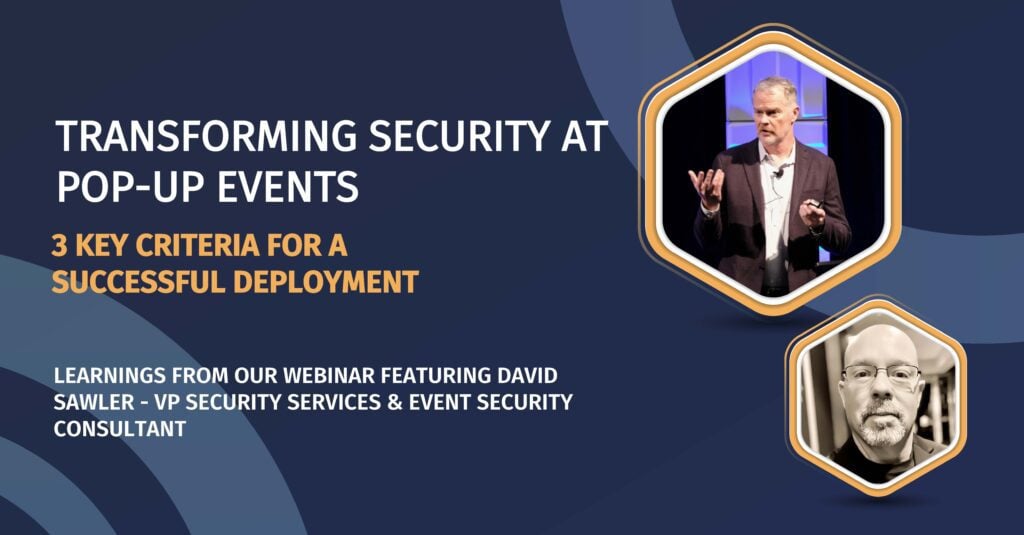
On the most recent episode of our Talking Physical Security webinar series, Peter Evans spoke with David Sawler, vice president of Security Services at Patriot One. David has over 25 years of experience in creating and implementing physical and cybersecurity solutions around the world. Previously, David served as the director of Security for various sporting and entertainment events, including the Citi Open Tennis Tournament (ATP/WTA), Laver Cup and Palm Springs International Film Festival.
Peter and David discussed challenges for patron security screening during these “pop-up” events, notably the lack of a permanent building or structure. Or, for those taking place at a physical building, it’s not the organization’s official “home,” which presents challenges. David believes we can expect changes in how events are run based on ever changing operational and security needs. These could range from staffing and management to the number of entrances that patrons and staff need to use – with different organizations needing different security screening practices and layers of security.
With the major shift in how the industry will view threats in the future, i.e., screening for “weapons” instead of “metal,” there are high expectations for the types of products and services being offered by way of physical security.
Key Criteria for Physical Security at Pop-up Events
Throughout their discussion, Peter and David spoke about key criteria that need to be in place to have a successful physical security deployment at a pop-up event. Here are three things venue and event directors should prioritize:
- Honest discussions about how the product works
David says the smoothest deployments happen when the vendor providing the security technology is honest about the product’s performance capabilities and weaknesses. Operational understanding is essential and will help venue directors foresee issues on the day of the event. For example, if the system cannot detect weapons within high clutter environments, bags will need to be searched individually or prohibited. Or if the technology has trouble in inclement weather, that could affect the security process, depending on what the event is.
Companies that claim to have a 100% success rate for detecting weapons with no false positive alerts are the ones venues need to be wary of. Every system has weaknesses, and being upfront about those will ensure success during the event.
- Using technology that transforms security guards
With the ongoing worker shortage that the U.S. is facing, venues need to be using their workforce to its full potential. This means implementing technology that will elevate security guards into security professionals. The “Great Resignation” has left fewer people on jobsites than before, so optimizing the security guards venues do have is critical. This means implementing technology that will allow personnel to be proactive in protecting staff and patrons, and giving them the tools to be successful.
Sometimes it’s difficult for people who have been in the industry a while to adapt to this kind of change, but the new skills they will obtain are invaluable. Thoroughly training guards in using this new technology will be essential to ensure proper use. So even though there may be less people standing guard, the ones who are doing it will be equipped with more actionable information. David added that even with next-gen screening technology, security will always need a human component, but it will be evolved from the typical “body on post” scenarios that we are used to.
- Seeing the bigger picture
Sometimes, executives are hesitant to implement modern security screening technology because of the upfront costs that any new technology will require. However, it’s important that these executives understand that the cost of not taking these steps outweighs the cost of implementing them. David said that he has been brought on by some events after a major security incident caused a lawsuit, costing them thousands of dollars – not to mention their reputation – and implementing next-gen security technology may have helped them avoid that incident in the first place.
He added that it’s essential to get venue leaders to realize using these solutions is critical in this day and age − not optional − and that the cost of not doing so could be exponentially higher.
Peter and David ended their discussion by talking about what excites them the most – which is where this technology, like Patriot One’s solutions, is heading. It is already being used in stadiums and large venues across the country, and with continued innovations and adoption, it will continue to elevate safety and the fan experience. These high throughput, free-flow systems are allowing patrons to enter events quickly and happily, while at the same time, enhancing security. Now, venues don’t need to decide which is more important to them – security or the fan experience – they can have it all.
To catch a replay of this webinar, click here.
